
![]()
Search the Journey to Forever website – click HERE
|
Journey to Forever: Make a donation |
Navigation
| Small farms library | |
| City farms | |
| Organic gardening | |
| Composting | |
| Introduction Compost and organics What is compost? |
|
| Making compost | |
| Good compost How not to fail Greens and browns Hints Compost containers Assembling the materials Adding liquids Batches Animal manure Sifting Cold weather |
|
| Composting resources | |
| Virtual composting Core texts General composting |
|
| Composting indoors | |
| Think small Filling the bin Problems Think even smaller Resources |
|
| Vermicomposting | |
| Vermicompost and plants The worms Breeding Worm boxes Dimensions Bedding Feeding Harvesting Problems Garden wastes Using vermicompost Resources |
|
| Humanure | |
| Foundation work Modern developments Best of all! |
|
| Composting for small farms | |
| Foundation work On-farm composting resources |
|
| Small farms | |
Contact usTo Keith Addison Handmade Projects |
Humanure
The most wasteful piece of equipment ever devised -- the flush toilet.
"Nearly a third of all household drinking water in the US is used to flush toilets" -- Joseph Jenkins, "The Humanure Handbook"
"The function of all organic matter, animal and vegetable, is to maintain the fertility of the soil" -- J.C. Wylie, "The Wastes of Civilization"
Journey to Forever founder member Keith Addison composted humanure when he ran a smallholding in England in the late 1980s. "It was completely innocuous," he says. "One day the landlord and his wife visited us from the Big House. We all had tea on the lawn, a few feet away from a big compost unit with a lot of humanure in it. They didn't notice anything -- her ladyship even spent a while leaning against it while we were chatting. The compost temperature in that unit went up to about 70 degrees Centigrade, so it was completely sanitized. It made good compost."
Foundation work
The Moule Earth Closet "Essays on Rural Hygiene" by George Vivian Poore, MD, second edition, 1894, Longmans, Green, London. Composting toilet resources at The Compost Resource Page: Human Urine Safe, Productive Fertilizer, by Carolyn Colwell, Washington Post, October 8, 2007 — Cash-strapped farmers shouldn't look far for a source of free fertilizer, according to a new study that finds human urine to be a great source of nitrogen and other minerals. Source: Journal of Agricultural and Food Chemistry, Oct 31 2007
In 1859 the Rev Henry Moule of Dorset in England decided the family cess-pit was a foul abomination, had it filled in, and told his family to use buckets, the contents to be emptied and buried in trenches in the garden -- where, within weeks, "not a trace of it could be discovered". What could soon be discovered was a "luxuriant growth of vegetables in my garden" -- and that dry surface earth, not water, was the place for "offensive matters". He wrote a pamphlet on it: "National health and wealth, instead of the disease, nuisance, expense, and waste, caused by cess-pools and water-drainage", and became a tireless campaigner for his by-now patented Moule Earth Closet (No 1316, 1860) -- wondrous Victorian-style machines which "flushed" dry earth via a lever, or automatically when you stood up, with luxury models in mahogany and oak. The soil could be dried and re-used up to seven times without offence or nuisance. It was a powerful fertilizer: a neighbouring farmer's swedes grew a third bigger when he used it instead of superphosphates. "Manure for the millions," Moule wrote in a letter to the cottage gardeners of England. Schools used them, and barracks, The Lancet wrote of them glowingly, even Queen Victoria had an earth closet (though of course she never had to use it...). But in the end the sheer mindless convenience of the water closet (flush toilet) won the battle -- though perhaps not yet the war.
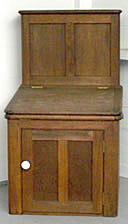
Moule's Patent Earth Commode Pat. 1869 -- Mark Henderson
http://www.jldr.com/
ohcloset.html
http://www2.exnet.com/1996/01/15/science/science.html
Dr. Poore called his book "Rural Hygiene" because "it is in the country alone that it is possible to be guided by scientific principles in our measures for the preservation of health and the prevention of disease. In cities the hygienic arrangements are the results of expediency rather than principle". He quoted Cowper: "God made the country and man made the town." In the country, "the householder is able to make his sanitation complete, and to finish, on his own premises, and to his own profit, that 'circulation of organic matter' which is the law of nature, and the only true basis upon which the science of sanitation can possibly stand firm". His solution involved the daily use of nightsoil in a highly successful system of horticulture developed over 20 years -- in other words, he buried it, and then he raised crops on it. And he demonstrated it was hygienic. "The gardener and the farmer are the right-hand men of the sanitarian." Indeed. The later development of the Indore composting system made these truths just as applicable to the town. Full-text pdf (13Mb) online for free downloading at the Internet Archive:
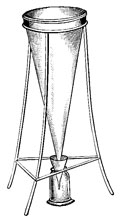
Poore's earth tests: earth in the funnel, urine in the top, water out the bottom
http://www.archive.org/download/essaysonruralhyg00poorrich/
essaysonruralhyg00poorrich_bw.pdf
"Soil Fertility and Sewage -- An account of Pioneer Work in South Africa in the Disposal of Town Wastes" by J.P.J. van Vuren, with a foreword by Lady Howard, 1949, Faber & Faber, London.
A detailed and scientific survey of the results of 10 years' labour applying the Indore composting system to recycling town wastes and nightsoil in South Africa. By the time this book was published half a million cubic yards of urban compost a year were being made in South Africa, and being sold at a healthy profit. Van Vuren never loses sight of the ultimate purpose: "Cities and towns have for too many centuries been veritable graveyards where, in most instances, only the charred remains of the youth and life of many a soil --- and ultimately civilization -- lie buried and forgotten. It is our duty, as well as our privilege, to ensure that such destructive, almost criminal, practises are no longer allowed to continue." The book is "Dedicated to the first ten inches of soil."
For an introduction to Van Vuren's pioneering work, see The Utilization of Municipal Wastes in South Africa (full text online at Journey to Forever) by J.P.J. van Vuren, Appendix C in "Farming and Gardening for Health or Disease (The Soil and Health)" by Sir Albert Howard.
Sir Albert Howard always looked to the forest for the perfect model of nature's methods: "The forest suggests the basic principle underlying the correct disposal of town and village wastes in the tropics. The residues of the trees and of the animal life, met with in all woodlands, become mixed on the floor of the forest, and are converted into humus through the agency of fungi and bacteria. The process is sanitary throughout and there is no nuisance of any kind. Nature's method of dealing with forest wastes is to convert them into an essential manure for the trees by means of continuous oxidation. The manufacture of humus from agricultural and urban wastes by the Indore Process depends on the same principle." With techniques and successful applications, in The Manufacture of Humus from the Wastes of the Town and the Village (full text online at Journey to Forever), by Sir Albert Howard.
"The Wastes of Civilization" by J.C. Wylie, 1959, Faber & Faber, London.
This is a history of the wastefulness of man. It begins with the kitchen middens of Neolithic man and continues through the refuse-strewn streets and pest-ridden houses of mediaeval towns to the clean cities of today -- where we simply try to hide the wastes from view, and try to turn a blind eye to the nauseating dumps, polluted rivers and coastal waters, and the worn out soils which result. "The function of all organic matter, animal and vegetable, is to maintain the fertility of the soil," Wylie writes, and shows how it's to be done, economically and hygienically, through mechanized composting, solving the ancient problem at long last.
"Fertility from Town Wastes" by J.C. Wylie, with a Foreword by Sir Cedric Stanton Hicks, 1955, Faber & Faber, London
"A work of the greatest importance... it cannot be too highly recommended," said Mother Earth in its review of this book. The Spectator praised its "evocative literary quality" -- not something you expect to find in a book about garbage and toilets, but it's a good read. Intelligent and thorough treatment of the nature, value, treatment and disposal of organic and inorganic wastes, cleverly linked to soil fertility and food conservation problems. With work of this calibre done 50 years ago, along with that of Van Vuren and others, it makes you wonder what shred of an excuse the world's municipal and sanitation authorities, and all the other authorities, can offer for the trillions upon trillions of gallons of precious water wasted on sewage, the pollution it causes, the huge areas of land devoted to landfills, the pollution that causes, and the continuing food scares, which relate straight back to the soil fertility problem. Answer: no excuse at all.
"Composting -- Sanitary Disposal and Reclamation of Organic Wastes" by Harold B. Gotaas, Professor of Sanitary Engineering, Department of Engineering, University of California, Berkeley, California, USA, 1956, World Health Organization, Geneva.

Composting nightsoil and city refuse in China in the late 1970s.
"Sanitary treatment of organic waste materials for the protection of health and preparation of wastes for utilization in agriculture are compatible," says Prof. Gotaas. This book discusses "the fundamental aspects of composting, which are the basis for satisfactory processes". Pioneering work was done on composting at Berkeley in the 1950s. Gotaas uses Howard's Indore composting system as the basis for dealing with the sanitary composting of wastes and nightsoil in cities, towns and villages, and on farms, using examples from around the world.
History of Plumbing in America
http://www.theplumber.com/usa.html
Modern developments
http://www.oldgrowth.org/compost/
City Farmer has extensive links and resources on Composting Toilets -- and they use them on their city farm.
http://www.cityfarmer.org/comptoilet64.html#toilet
"The Humanure Handbook -- a Guide to Composting Human Manure" by Joseph Jenkins, 1999, 2nd Edition, Jenkins Publishing.
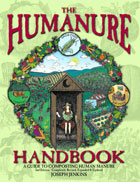 How-to manual on composting human manure. Jenkins is a humanure composting practitioner and organic gardener. Radical (as it needs to be): "Defecating in our drinking water is perhaps one of our culture's most curious, but least talked about, habits." Practical and well researched guide, covers the decomposition process, toilet design, pathogens, use of organic products, and much more. It's a good read too. Includes low-tech systems with plans for a sawdust toilet, using no electricity and minimal water, coupled with thermophilic (hot) composting to destroy pathogens and produce a valuable compost soil conditioner. Illustrated, tables and charts, 304 pages.
How-to manual on composting human manure. Jenkins is a humanure composting practitioner and organic gardener. Radical (as it needs to be): "Defecating in our drinking water is perhaps one of our culture's most curious, but least talked about, habits." Practical and well researched guide, covers the decomposition process, toilet design, pathogens, use of organic products, and much more. It's a good read too. Includes low-tech systems with plans for a sawdust toilet, using no electricity and minimal water, coupled with thermophilic (hot) composting to destroy pathogens and produce a valuable compost soil conditioner. Illustrated, tables and charts, 304 pages.
http://www.jenkinspublishing.com/
Online version:
http://www.weblife.org/humanure/
-- "Thermophilic microorganisms, such as bacteria and fungi, can create an environment in the compost which destroys disease organisms that can exist in humanure, converting humanure into a friendly, pleasant-smelling, humus safe for food gardens. Thermophilically [hot] composted humanure is entirely different from night soil. 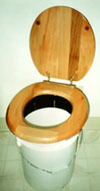 Perhaps it is better stated by the experts in the field: 'From a survey of the literature of night soil treatment, it can be clearly concluded that the only fail-safe night soil method which will assure effective and essentially total pathogen inactivation, including the most resistant helminths [intestinal worms] such as Ascaris [roundworm] eggs and all other bacterial and viral pathogens, is heat treatment to a temperature of 55 to 60 deg C for several hours.' The experts are specifically referring to the heat of the compost pile." -- Joseph Jenkins, "The Humanure Handbook"
Perhaps it is better stated by the experts in the field: 'From a survey of the literature of night soil treatment, it can be clearly concluded that the only fail-safe night soil method which will assure effective and essentially total pathogen inactivation, including the most resistant helminths [intestinal worms] such as Ascaris [roundworm] eggs and all other bacterial and viral pathogens, is heat treatment to a temperature of 55 to 60 deg C for several hours.' The experts are specifically referring to the heat of the compost pile." -- Joseph Jenkins, "The Humanure Handbook"
How to make and use a simple "sawdust" toilet:
http://users.easystreet.com/ersson/sawdust.htm
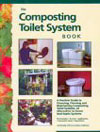 "The Composting Toilet System Book: A Practical Guide to Choosing, Planning and Maintaining Composting Toilet Systems" by David Del Porto and Carol Steinfeld, 1999, Chelsea Green, ISBN: 0966678303
"The Composting Toilet System Book: A Practical Guide to Choosing, Planning and Maintaining Composting Toilet Systems" by David Del Porto and Carol Steinfeld, 1999, Chelsea Green, ISBN: 0966678303
David Del Porto has sold and serviced thousands of composting toilet systems and has designed composting toilet and greywater systems for Greenpeace and for developing countries. Carol Steinfeld is a free-lance writer, editor and technology transfer specialist focusing on ecological resource solutions. She is co-founder of the Center for Ecological Pollution Prevention (CEPP). Descriptions of more than 40 systems, covers ready-made and home-built systems, wet and dry toilets, self-contained composters and central units. Features unsaturated aerobic systems, but also covers separation (black and grey and shades of grey water) issues, dry and urine-separating toilets of various designs worldwide, greywater covered in depth, what plants to use to consume the water and nutrients, plus the composting process.
From the Center for Ecological Pollution Prevention (buying direct from the CEPP helps support their work):
http://www.cepp.cc/products.html#CTSBook
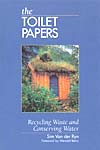 "The Toilet Papers: Recycling waste and conserving water" by Sim Van Der Ryn, 1995, Chelsea Green, ISBN: 0964471809
"The Toilet Papers: Recycling waste and conserving water" by Sim Van Der Ryn, 1995, Chelsea Green, ISBN: 0964471809
A classic back in print, with a foreword by Wendell Berry -- informative and irreverent look at human waste through the centuries, and what options are available today. Homeowner plans for several types of dry toilets, compost privies and grey water systems. Van der Ryn is a former architect, sound and elegant designs. "One of the favourite books of the back-to-the-land movement." From Chelsea Green:
http://www.chelseagreen.com/1999/items/toiletpapers
"Future Fertility: Transforming Human Waste Into Human Wealth" by John Beeby, 1995
"Despite all of the knowledge humankind has accumulated in the past 10,000 years, we still do not know fully how to use our urine and manure to fertilize our farmlands in a way that is simple and efficient, will not spread disease, and will benefit the soil. This knowledge is increasingly important as soils continue to lose the minerals and organic matter they need to remain fertile. Discovering how to utilize our waste as fertilizer is the challenge we must meet if our farmlands are to continue to provide us with food." Detailed and practical manual, describes established and innovative low-technology methods of safely and effectively recycling the nutrients in human waste, the principles behind the methods, and criteria to ensure human waste is processed safely and the fertility of the soil maintained. A must for those interested in transforming their waste into wealth in the future. From Bountiful Gardens:
http://www.bountifulgardens.org/growbiointensive-books.html#7
Compost toilets -- 5-page Technical Brief by Paul Calvert, based on his experience designing and building compost toilets in India -- Intermediate Technology Development Group (ITDG), Acrobat file, 284 K
http://www.itdg.org/html/technical_enquiries/docs/compost_toilets.pdf
Goodbye to the Flush Toilet: Water-Saving Alternatives to Cesspools, Septic Tanks, and Sewers, by Carol Hupping Stoner, Rodale Press, 1977, ISBN O-87857-1 92-2, 287 pages. Free download from the CD3WD 3rd World online library, 24.5Mb pdf
http://www.fastonline.org/CD3WD_40/JF/423/17-393.pdf
Compost, fertilizer, and biogas production from human and farm wastes in the People's Republic of China. Ottawa, IDRC, 1978, ISBN 0-88936-140-l, 94p. Editors Michael G. McGarry and Jill Stainforth, translated by Lee Thim Loi from "A Compilation of Data on the Experience and Sanitary Management of Excreta and Urine in the Village", published by The People's Hygiene Publisher, People's Republic of China. Free download from the CD3WD 3rd World online library, 7.8Mb pdf
http://www.fastonline.org/CD3WD_40/JF/432/24-573.pdfUrine as fertiliser
http://www.washingtonpost.com/wp-dyn/content/article/2007/10/08/AR2007100801028.html
Gee Whiz: Human Urine Is Shown to Be an Effective Agricultural Fertilizer, by Mara Grunbaum, Scientific American, July 23, 2010 — Researchers say our liquid waste not only promotes plant growth as well as industrial mineral fertilizers, but also would save energy used on sewage treatment.
http://www.scientificamerican.com/article.cfm?id=human-urine-is-an-effective-fertilizer
Guidelines on the Use of Urine and Faeces in Crop Production, Stockholm Environment Institute, 2004, 43-page pdf, 2.4 Mb
http://www.ecosanres.org/pdf_files/ESR_Publications_2004/ESR2web.pdf
Urine Diversion: One Step Towards Sustainable Sanitation, EcoSanRes Programme, Stockholm Environment Institute, 2006, 76-page pdf, 2.9 Mb
http://www.ecosanres.org/pdf_files/Urine_Diversion_2006-1.pdf
Best of all!
 "The Specialist" by Charles Sale, Putnam, ISBN 0911416005
"The Specialist" by Charles Sale, Putnam, ISBN 0911416005
The wonderful story of Lem Putt, country carpenter and specialist builder of privies. Lem actually existed, and Chic Sale knew him, and both lampoons him and respects him as "an artist in his way". Sale was an actor and "performed" this story hundreds of times, and by the time he wrote it (to copyright it in order to stop other actors stealing it) he had it honed to perfection. It's a rare delight. And it's more than that: Lem Putt knew his business. "There's a lot of fine points to puttin' up a first-class privy that the average man don't think about. It's no job for an amachoor, take you my word on it. There's a whole lot more to it than you can see by just takin' a few squints at your nabor's." This is what a water and sanitation engineer who works in developing countries said about it: "If I could recommend one course book for all wastewater engineers this would be it." Not just wastewater engineers -- Lem Putt's fine points should be everybody's fine points. Full text online at the Small Farms Library.
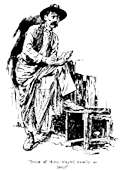 "Now," I sez, "how do you want that door to swing? Openin' in or out?" He said he didn't know. So I sez it should open in. This is the way it works out: Place yourself in there. The door openin' in, say about forty-five degree. This gives you air and lets the sun beat in. Now, if you hear anybody comin', you can give it a quick shove with your foot and there you are. But if she swings out, where are you -- can't run the risk of havin' her open for air or sun, because if anyone comes, you can't get up off that seat, reach way around and grab'er without gettin' caught, now can you. He could see I was right. So I built his door like all my doors, swingin' in, and, of course, facin' east to get the full benefit of th' sun. And I tell you gentlemen, there ain't nothin' more restful than to get out there in the mornin', comfortable seated, with th' door about three-fourths open. The old sun beatin' in of you, sort of relaxes a body -- makes you feel m-i-g-h-t-y, m-i-g-h-t-y r-e-s-t-f-u-l.
"Now," I sez, "how do you want that door to swing? Openin' in or out?" He said he didn't know. So I sez it should open in. This is the way it works out: Place yourself in there. The door openin' in, say about forty-five degree. This gives you air and lets the sun beat in. Now, if you hear anybody comin', you can give it a quick shove with your foot and there you are. But if she swings out, where are you -- can't run the risk of havin' her open for air or sun, because if anyone comes, you can't get up off that seat, reach way around and grab'er without gettin' caught, now can you. He could see I was right. So I built his door like all my doors, swingin' in, and, of course, facin' east to get the full benefit of th' sun. And I tell you gentlemen, there ain't nothin' more restful than to get out there in the mornin', comfortable seated, with th' door about three-fourths open. The old sun beatin' in of you, sort of relaxes a body -- makes you feel m-i-g-h-t-y, m-i-g-h-t-y r-e-s-t-f-u-l.
-- Lem Putt, Specialist
City farms
Organic gardening
Building a square foot garden
Plant spacing guides
No ground? Use containers
When to sow what
Seeds
Garden pond
Gardening resources
Composting
Making compost
Composting resources
Composting indoors
Vermicomposting
Humanure
Composting for small farms
Small farms
Small farm resources
Community-supported farms
Farming with trees
Farming with animals
Pasture
Pigs for small farms
Poultry for small farms
Aquaculture for small farms
Composting for small farms
Controlling weeds and pests
Small farms library